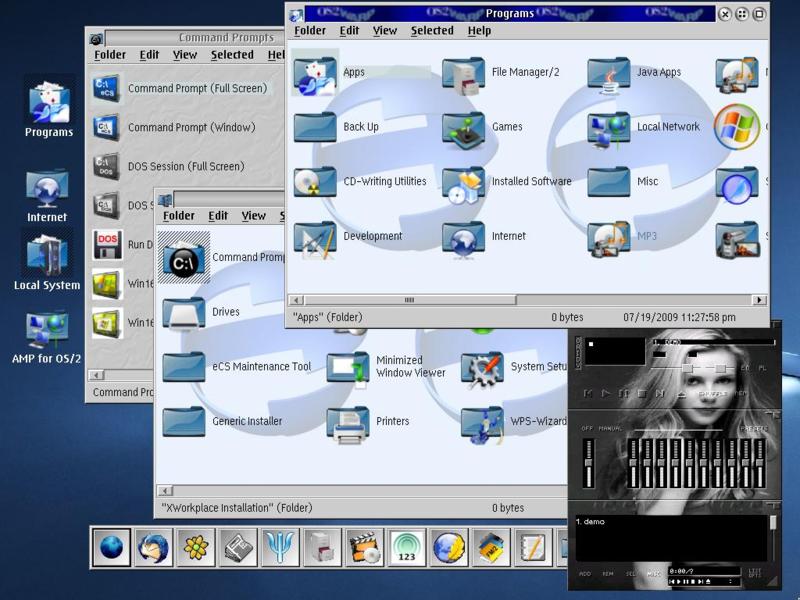|
eComStation 2.0 Review
eComStation 2.0 gets the basics right, but here's what you need to know about the new OS.
by Greggory Shaw

Introduction
It has been over 5 years since the last release of eComStation the
successor to IBM's OS/2 Warp. And to say it one more time, OS/2 is still not dead
it was just rebrand and is now being sold under the name of eComstation
by SSI. For those of you that do not know about the history of IBM's OS/2 Warp it
started out as an joint venture between IBM and Microsoft. However, Microsoft pulled
out of the agreement and continued on their own project that eventuallly became
the Windows operating system. The full history of OS/2 can be found on the Net, so
I will not repeat it again here.
There are a lot of new and welcome features added to eComstation 2.0, but after
5 years between releases are a couple featues missing that should be. The main two
are network connectivity and printer support. Both are up and coming, and due with the
release of eCs 2.1 by the way of Samba and eCup from the Linux world.
New Features for eCS 2.0
Here is the short list of new features in eComstaton 2.0: Preboot menu changes
The Preboot menu has been changed to accomodate an easier selection of
the
target hardware and preset some configuration options automatically.
The following options are available:
- Legacy hardware
- Modern hardware, safe mode
- Modern hardware, ACPI
- Virtual Machine
Please see the README document for more details.
Bootable JFS
This release of eComStation contains the option to install the operating
system on a JFS volume. The advantage of doing this is that the amount
of diskcache is only limited by system memory
(typically 10% of available memory is assigned) This increased cache
size gives a huge gain in overall system performance.
HDA Audio support
The support for HDA audio controllers on new mainboards is greatly
improved
since the previous release candidate of eComStation 2.0. It is now
detected
and installed on most supported systems.
Panorama VESA video driver installation
This version of eComStation allows the installation of the Panorama VESA
videodriver, to enable
accelerated display on video chipsets currently unsupported by Scitech
SNAP.
Netware installation
This version of eComStation allows the installation of the Netware
client software and utilities straight from the regular installer. It is
integrated in the network pages and makes it easier to setup eComStation
as a workstation in a Netware environment.
Disk Resizer GUI
This beta has a custom DFSee engine that enables reliable RESIZING of
FAT32 and NTFS filesystems to allow
shrinking an existing Windows installation to make room for eComStation
on the same system.
The GUI to this tool has been updated and is now using a graphical
interface. To invoke it, please select 'Paritition Resizing Tool' from
the Installation Volume Manager which
can be called during installation.
GenMac support
This package provides generic driver support for several network
interface cards under OS/2 and eComStation.
Moreover, Genmac is enabled to support WPA encryption with the Wireless
LAN Monitor 3.x or better.
Genmac and the Wireless LAN monitor will be installed when the
appropriate hardware is detected by the installer.
If it is not detected, you can manually select the driver in the network
installation dialog.
ACPI 3.17
ACPI support has been updated to the latest available version (3.17)
which results in varying successrate. For example, AMD Opteron multicore
CPU is now reported to be supported.
Installation of ACPI has been improved by the use of the ACPI Wizard,
which tries to determine system configuration and set parameters
accordingly. You can manually change them of course.
It will be run after regular installation has completed.
multicore CPU support
This beta supports the installation of eComStation on a MultiCore CPU
computer. This includes Intel Core Duo, Core2 Duo and AMD 64 X2.
To enable it, you can do so in the ACPI Wizard that is launched from the
Post Installation tasks at the end of the installation. Alternatively
you can start the ACPI Wizard at any time from the install/remove folder
in the Local System folder on the desktop.
eComStation Virtual File System (Samba client support)
Samba is a SMB/CIFS protocols file and print sharing server/client set
originally made for UNIX world to cooperate with corresponding Windows
and OS/2 servers or clients. eComStation has a native implementation of
SMB/CIFS server/client set - IBM LAN Manager and IBM Peer. These
products have not been recently updated and may have some compatibility
issues with modern Windows SMB/CIFS implementations.
Serenity Systems International has reached an agreement with Blueprint
Software Works for the inclusion of the 'eComStation Virtual File
System' driver which provides support for Samba Client.
EVFS GUI
There now is a GUI that will make it easier to configure network access
using the Samba protocol. There is one big limitation though, the tool
cannot determine if a network connection was properly created - so it
will not provide sensible feedback on that, instead it will always
create a mountpoint which may be empty if the actual connection fails.
The object for this tool is placed in the "Local Network" folder and is
called "Virtual Filesystem for SMB".
HardwareI have two old computers a Compaq Presario 4100NX
and a laptop Dell Latitude D810, and a newer Dell 531 that have no
problems with the installation of eComstation 2.0. However,
hardware is going to be hit or miss with your favorite window devices.
Especially the onboard HDA sound and more importantly the onboard
network controllers. If all else fails a sound card, nic, and video
card can be found on eBay for under $50 that work with eCS.
The
bottom line is that you need to check some of the eComstation hardware
compatiblity site's before you attempt to install eCS or even consider
purchasing eComstation. And if you can not install a new network card
or video card, then you should probably stay in the Windows world.
One
more thing to know about multi-processors CPUs with eCS. Depending on
your hardware setup your system may not be stable with SMP enabled, so
be prepared for this.
|





